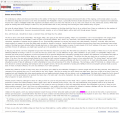Adult Attracted Minor
 | |||||||
| Part of NewgonWiki's series on minor-attracted identities | |||||||
|---|---|---|---|---|---|---|---|
|
| |||||||
| Starting Guide | Community | Pediverse MAP | NOMAP | AAM | Neologisms "MAP" Origins | Flag | Movement Political history: MAP & LGBT Alliances Philias: Ephebo - Hebe - Pedo - Nepio Gender and attraction: BL - EL - GL Pederasty/Gay BL | Korephilia/Lesbian GL Pro-c | Neutral-c | Anti-c BLogo | GLogo | |||||||
|
| |||||||
| Category: Minor-attracted people | |||||||
| Template:MAI - This template |
Adult Attracted Minor (or AAM) is a neologism referring to a legal minor who is sexually/romantically attracted to those who are legal adults. This may be a preferential or non-preferential attraction - however, the term is often conflated with all minors who seek sexual contact with adults. Attraction to sexually mature people is probably so common among pubescents, as to render use of the term meaningless, especially when applied to all attractions, whether preferential or not. However, large swathes of western society still refuse to accept this, or at least the idea that it is "appropriate". This is the most likely reason why AAM has almost immediately been ascribed a behavioral definition by most observers - as behavior is an undeniable indication of some psychological impulse.
Most minor attracted people profess an opposition to pursuing relationships with minors, regardless of whether they are in favor of easing age of consent laws. Behavioral data documenting the high frequency of attraction to minors in the general population and low frequency of pedophilia in the criminal population, all but confirms the existence of numerous non-offending MAPs and pedophiles in society.
Origin
AAM (as commonly used) is likely to have emerged out of the 2018-19 publicity surrounding the term "Minor Attracted People" and the MAP Flag. However, early uses have been located on old web-forums as early as 2002[1], and also by Pedologues broadcaster Rookiee, as a "mirror image" of "Minor Attracted Adult" on his blog, Paiderastia, in May of 2006.[2]
AAM Activism
AAM activism is often seen as an acid-test for pro-c MAP activists. If and when minors are able to freely speak out, the upside risk for MAP activism in general, increases exponentially. Mark Moffett Jr, covered in Youth Perspectives was the most famous AAM activist, although he will not have used the term to describe himself.
Official Guidance⁽ᵂʰᵃᵗ ᶦˢ ᵗʰᶦˢˀ⁾ - Spotting fake/bait AAMs
Fake/bait AAM personas used by anti-MAP vigilantes are known to demonstrate a few common traits (see gallery below):
- Anonymous, non-photographic persona, fake/stolen photos, or otherwise will not "flash" face or private features, as they are an adult.
- Forward with sexual advances, requests for photographs. Ever so happy to "meet" after a photo and some sweet words. No actual minor would be!
- Types in the style of a bored housewife impersonating a stereotyped teen. Repeats "lol" - is this really how teens communicate? Performative cutenessss.
- Inconsistency in confected traits such as decapitalization.
Newgon Organization strongly warns its followers against the idea of communicating with supposed minors for "sexual" purposes. If a person finds it impossible to resist fantasy cybersex, they should make it clear from stage one (and record it), that it is a fantasy discussion, and that they believe beyond reasonable doubt, that they are communicating with an adult. Under some laws (e.g. "Sexual Communication With a Child" in the UK) meeting a decoy isn't even necessary for a conviction.
Who has an "AAM problem"?
Multiple moral "gatekeepers" of social media, including members of the LGBT community (where "loved boys" were sheltered in the 70s, 80s and even 90s) are known to police and report AAMs. They derogatorily refer to them as a "problem". One of the ironies of this policing action, is that many of the self-proclaimed AAMs are likely to be poseurs, members of Anonymous or organized criminals.
- Twitter.com - according to numerous people on said website.
- Discord - frequently claimed on social media.
- Chansites.
- Modern social media platforms in general.
Gallery
-
First mentioned in 2006
-
Examples of minors or purported minors seeking to sell content on Twitter.com
-
Example of a more obvious fake AAM


